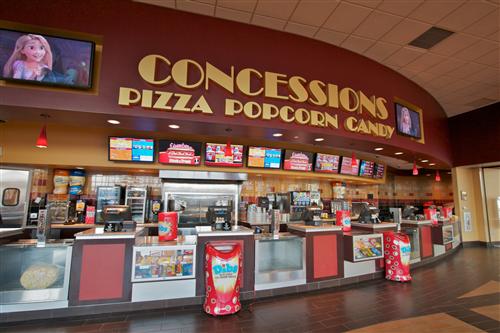 The snack counter at Marcus Theaters offers White Castle burgers, ice cream and more.As vaguely recall, my last in-theater dining experience involved chicken tacos that I washed down with a glass of wine (or was it rum punch? They’re pretty much the same thing, right?!). Accompanied by a friend enjoying a small bowl of mac & cheese, I watched the evening’s feature presentation while seated near people eating cheesesteaks and sipping martinis.
The snack counter at Marcus Theaters offers White Castle burgers, ice cream and more.As vaguely recall, my last in-theater dining experience involved chicken tacos that I washed down with a glass of wine (or was it rum punch? They’re pretty much the same thing, right?!). Accompanied by a friend enjoying a small bowl of mac & cheese, I watched the evening’s feature presentation while seated near people eating cheesesteaks and sipping martinis.
Those tacos were mighty tasty, yet, it’s rare for you to find me snacking on goodies from the concession stand at the multiplex. Sometimes I buy nachos or Twizzlers. On most occasions, however, I eat nothing during my trips to the cinema. Given that theaters usually make an estimated 85% profit from concession sales, accounting for nearly half of their overall profits, you can understand how much of an anomaly I am where movie snacks are concerned.
Unless you've been living in a cave, you know that the way to the industry’s survival is through moviegoers’ stomachs. Modern day theaters are even focused on gourmet level dining and offer an expanded menu to make your night out at the movies similar to a Broadway show, according to Natasha Geiling at Smithsonian. If history has taught us anything, however, it’s that popcorn may always reign supreme at concession stands in America.
Even actress and comedian Lily Singh aka Superwoman doesn’t go to theaters to watch the movie -- she goes for the “buttery popcorn,” which Rachel Friedman at Bon Appétit notes as the #1 best seller followed by soda, pretzels, nachos and hot dogs. That said, the motion picture industry’s relationship with snack food has not always been a match made in heaven. Their courtship began as a rather rocky one since the early 1900s when popcorn was being sold pretty much everywhere except at the cinema. Although this snack gained popularity at carnivals, sporting events, etc. theater owners refused to tolerate any food whatsoever inside their venues.
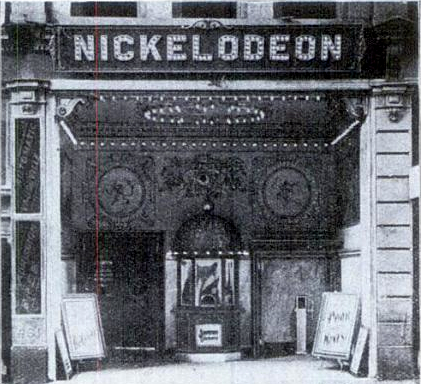 Harry Davis' Nickelodeon theater is featured in "The Emergence of Cinema: The American Screen to 1907, Volume 1" by Charles Musser. These vaudeville theaters – showing short films in between live performances such as musicals, juggling acts, comedy and stage plays -- considered popcorn to be beneath the sophisticated impression they wanted to make on middle-class patrons. They viewed popcorn as disruptive and associated it with unruly crowds that were common at burlesque shows and nickelodeons -- makeshift storefront theaters that spread rapidly throughout the U.S. after Pittsburgh tycoon Harry Davis opened one in 1905.
Harry Davis' Nickelodeon theater is featured in "The Emergence of Cinema: The American Screen to 1907, Volume 1" by Charles Musser. These vaudeville theaters – showing short films in between live performances such as musicals, juggling acts, comedy and stage plays -- considered popcorn to be beneath the sophisticated impression they wanted to make on middle-class patrons. They viewed popcorn as disruptive and associated it with unruly crowds that were common at burlesque shows and nickelodeons -- makeshift storefront theaters that spread rapidly throughout the U.S. after Pittsburgh tycoon Harry Davis opened one in 1905.
Although nickelodeons did not sell food inside their theater, patrons bought snacks and drinks in from nearby candy shops, writes Friedman. Nickelodeons also allowed self-employed vendors to roam the aisles, selling popcorn and peanuts to audience members. When Hollywood introduced feature films, admission tickets started to rise and the nickelodeon theater craze phased out, as larger venues proved to be stiff competition with varied offerings in terms of new films and live shows.
Later, movie palaces came along in the 1920s; these venues had crystal chandeliers, antiques, marble-lined hallways and fancy carpets but were not built to accommodate concessions. Movie palaces lacked adequate room for a designated snack counter and they didn’t have ventilation. However, these limitations on concessions didn’t stop movie goers from smuggling Baby Ruths and other snacks in with them, according to Friedman. Street vendors would also set up popcorn machines near theaters and sell snacks. Since movie palaces were not keen on food littering their floors, Geiling says, managers hung signs outside coatrooms, requesting that patrons check their popcorn with their coats.
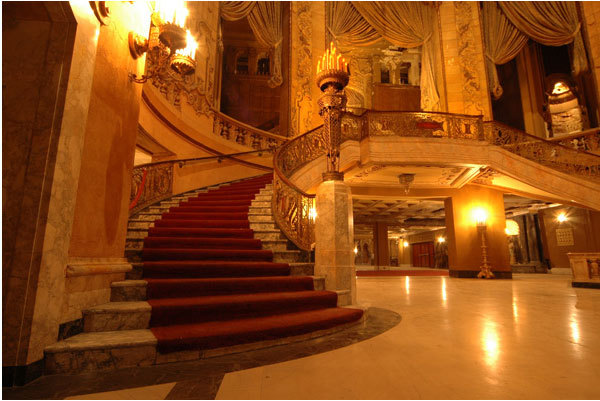 Built in 1925, Chicago's Uptown Theater was among the greatest movie palaces of its time. Photo courtesy of jetergaAround 1927, the advent of sound pictures aka “talkies” opened theaters up to wider audiences, since literacy no longer determined whether you could go to the movies or not. Geiling also writes that sound could muffle snacking noises, which meant talking pictures also brought more opportunities to profit from concessions…but…cinemas still wouldn’t budge on offering food to patrons.
Built in 1925, Chicago's Uptown Theater was among the greatest movie palaces of its time. Photo courtesy of jetergaAround 1927, the advent of sound pictures aka “talkies” opened theaters up to wider audiences, since literacy no longer determined whether you could go to the movies or not. Geiling also writes that sound could muffle snacking noises, which meant talking pictures also brought more opportunities to profit from concessions…but…cinemas still wouldn’t budge on offering food to patrons.
Theaters of this era believed any potential profit was not worth the hassle of cleaning up spilled popcorn and stains from soft drinks on their expensive rugs. During the Great Depression, movie theaters had a difficult time staying in business so they started leasing lobby privileges to popcorn vendors for $1 a day. Since many cinemas didn’t have a lobby, the vendors would rent space outside in front of a theater, which gave them an opportunity to profit by selling to moviegoers as well as passersby on the street. While the industry was finally warming up to popcorn, theaters did not allow peanuts because of the messy shells. A young man named Kemmons Wilson, who dropped out of high school to support his family during the Great Depression, was among these entrepreneurial vendors who capitalized on movie concessions.
According to Filmmaker IQ and Wilson Hotel Management, LLC, he purchased a popcorn machine on credit for $50 and got permission to sell it in front of a Memphis theater. Soon, he was earning more profit than the cinema and eventually, the theater manager kicked him out. Wilson then went on to run a successful franchise of pinball machines among other ventures, hiring other people (including his wife) to work for him. He also founded the Holiday Inn hotel chain and even opened 11 movie theaters, after vowing to his mother that no one would ever take his popcorn machine away from him again.
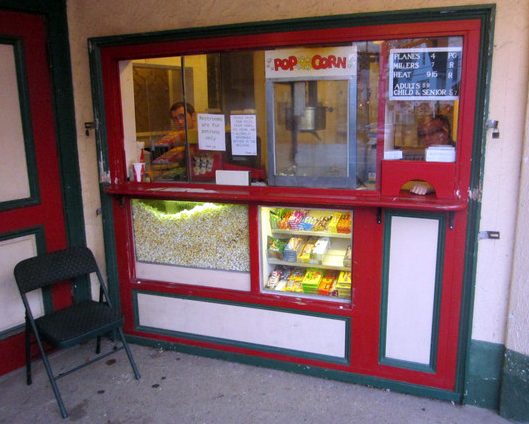 Concessions booth at the Capawock Theater in Massachusetts. Photo courtesy of bicyclereporterA lot of movie theaters went bankrupt in the 1930s and those that remained in business did so because they started offering refreshments to their patrons.
Concessions booth at the Capawock Theater in Massachusetts. Photo courtesy of bicyclereporterA lot of movie theaters went bankrupt in the 1930s and those that remained in business did so because they started offering refreshments to their patrons.
As soon as cinemas noticed that popcorn was selling like hotcakes due to its aroma, they added popcorn machines to their lobby as well as soft drinks and candy machines while word spread about how lucrative the snack business is for the motion picture industry.
1930s theaters were more modest in design compared to movie palaces of the 20s. Cinemas of this period also incorporated space for concession stands in their layout, helping to keep snacks an integral part of the movie going experience. According to Jill Pellettieri at Slate, theater owners also offered homemade bonbons, chocolates and candy apples, in an attempt to attract highbrow customers.
In Milwaukee Movie Theaters, Larry Widen writes that Coca-Cola, which sponsored Viktor Fleming’s 1939 romantic drama Gone with the Wind, insisted that theaters offer their soda throughout the entire run of the film. During WWII, the candy industry had setbacks due to sugar shortages and rationing, as exporters such as the Philippines were unable to reach the United States. Popcorn, which was cheap to buy, flourished during this time. Overseas, M&Ms became popular among GIs who received these candies as their rations.
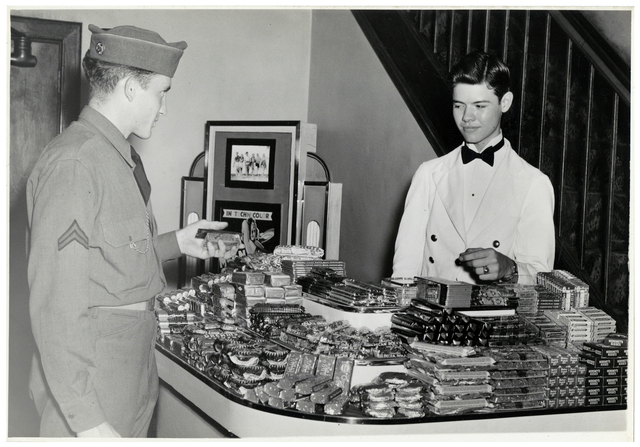 The Carolina Theater (turned Roger L. Stevens Center) in Winston-Salem provided a snack bar in the 1940s.When sugar returned to the U.S. after the war ended, this helped M&Ms obtain market growth and later find its place at movie theater concession stands among other new candy such as Junior Mints, Goobers and Milk Duds.
The Carolina Theater (turned Roger L. Stevens Center) in Winston-Salem provided a snack bar in the 1940s.When sugar returned to the U.S. after the war ended, this helped M&Ms obtain market growth and later find its place at movie theater concession stands among other new candy such as Junior Mints, Goobers and Milk Duds.
Soft drinks were also flowing and snack sales increased dramatically with movies aimed at children. Comedies brought in the highest profit from snacks while horror films generated the lowest sales, according to Andrew F. Smith in Fast Food and Junk Food: An Encyclopedia of What We love to Eat. Drive-in movie theaters, which opened after World War II, thrived as they offered luncheonettes and cafeterias. So, traditional movie theaters took a hit. 1950s art cinemas served free espresso coffee to increase ticket prices without raising operating expenses, writes Emanuel B. Halper in Shopping Center and Store Leases, Volume 2.
Skittles also made its way to the Cineplex after being imported from Europe in 1979. Soon, fast food companies wanted a piece of Hollywood’s concession stand pie. Burger King became known as the pioneer of movie tie-ins after inking a promotional deal with George Lucas’ 1977 epic adventure Star Wars. Then McDonald’s partnered with Disney and later switched to Burger King for a 10-movie deal that included films such as Aladdin, Toy Story and The Lion King. Amblin Entertainment approached Mars, Inc. in hopes of using M&Ms in Steven Spielberg’s 1982 Sci-Fi family flick E.T.: The Extra Terrestrial but they were turned down, writes Smith.
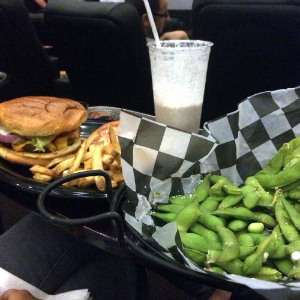 These days, moviegoers like Chlo L. can opt for a cheeseburger, Oreo milkshake and edamame at some theaters, as the concessions menu continues to get an upgrade.The producers then reached out to Hershey, which had a new candy on the block called Reeses Pieces. Both parties came to an agreement that allowed E.T. to munch on this candy in the movie, which resulted in millions of dollars in sales for Hershey, helping Reeses Pieces gain a foothold at the concession stand. While I would like to say the rest is history, my guess is this is just the tip of the iceberg regarding interesting factors that shape the snack menu offerings at theaters across the country.
These days, moviegoers like Chlo L. can opt for a cheeseburger, Oreo milkshake and edamame at some theaters, as the concessions menu continues to get an upgrade.The producers then reached out to Hershey, which had a new candy on the block called Reeses Pieces. Both parties came to an agreement that allowed E.T. to munch on this candy in the movie, which resulted in millions of dollars in sales for Hershey, helping Reeses Pieces gain a foothold at the concession stand. While I would like to say the rest is history, my guess is this is just the tip of the iceberg regarding interesting factors that shape the snack menu offerings at theaters across the country.
So the next time you visit the multiplex, remember that food at concession stands have come a long way from its days of being hawked on sidewalks and in aisles of 5-cent nickelodeons.
Would YOU still go to the movies if concession stands were banned?
Do you like YOUR popcorn served in a bag, a bucket, or some other type of container at the cineplex?
How well do YOU think vending machines or self-service food counters would be received at movie theaters?
Popcorn & Paninis is my rolling blog series exploring how food plays a role in the motion picture industry. Have some tidbits you’d like to add or a film-meets-gastronomy topic you think should be featured in this series? Ask away!